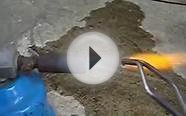Magnesium oxidation
 Photo of a laser-shock experiment in progress. For a brief second conditions similar to those of a planetary core are created © Eugene Kowaluk, Laboratory for Laser Energetics, University of Rochester
Photo of a laser-shock experiment in progress. For a brief second conditions similar to those of a planetary core are created © Eugene Kowaluk, Laboratory for Laser Energetics, University of Rochester
We take the Earth’s magnetic field for granted, but it is the only thing protecting us from the sun’s bombardment of lethal charged particles. Now, however, it seems there may be more planets outside our solar system with protective magnetic fields than previously thought. That’s the implication of a US study, which has demonstrated that the common planetary mineral magnesium oxide turns into a metallic liquid at high pressure.
Magnesium oxide is one of the simplest oxides present in terrestrial planets such as the Earth, as well as in the cores of giant planets such as Jupiter. Scientists are therefore keen to understand how its properties change under high temperatures and pressures. Theoretical predictions suggest that at very high pressures (0.3 to 0.7TPa) it should transform from a structure like sodium chloride, where each magnesium ion has six adjacent oxygen ions, to a structure like caesium chloride, where each magnesium ion has eight adjacent oxygen ions. Theory also predicts that at very high temperatures, typically greater than 5000K, magnesium oxide should turn into a liquid.
Unfortunately, current techniques have struggled to reach these pressures and temperatures. As a result, it has been impossible to map magnesium oxide’s actual phase changes. ‘Theorists have been publishing all these papers, ’ says author Stewart McWilliams at Howard University in Washington, DC. ‘I think they’ve been desperate for some experiments!’
McWilliams’s group, which includes colleagues at the University of California at Berkeley and Lawrence Livermore National Laboratory, also in California, has managed to perform the necessary experiments using a shock-compression technique. The researchers blasted a small piece of magnesium oxide with high-powered lasers to generate pressures beyond 1.4TPa and temperatures of about 50, 000 K. The blast sent a shockwave through the material, which the researchers monitored with a camera.
Shocking pressures
They found that the magnesium oxide changed from the NaCl-like structure to the CsCl-like structure at a pressure of 0.44TPa and a temperature of 9000K – broadly agreeing with the theoretical values of 0.33TPa and 8100 K, respectively. Meanwhile, the oxide changed into a metallic liquid at a pressure of 0.65TPa and a temperature of 14, 000 K – again broadly agreeing with the theoretical values of 0.59 TPa and 13, 600K.
You might also like



|
Formation of a compact oxide layer on AZ91D magnesium alloy by microarc oxidation via addition of cerium chloride into the MAO electrolyte.(Report): An article from: JCT Research Book (American Coatings Association, Inc.) |

|
100% PURE Magnesium Ascorbyl Phosphate MAPPowder Stable Vitamin C - 30g/1.1oz - Make your own Vitamin C Serum Beauty (HighAltitudeOrganics)
|








